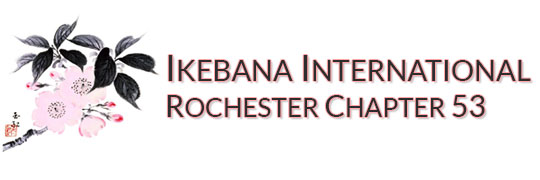Seasonal and Holiday Ikebana

The above arrangement was done by Gail Newman–a Junior Master in the Ichiyo School of Ikebana and the present president of the Ikebana International Rochester Chapter 53. She particularly enjoys using fall materials because of the multiplicity of colors and textures that comes with the season. As the viewer can see here, the brown color of the vase is reflected in the brown color of the leaves. And the black color of the blackberry lily (also known as the leopard lily) seed pods is also present in the middle of the sunflower blossoms. The yellowish orange of the sunflowers is also seen in the leaves. Not only is there the smooth appearance of the hosta leaves, but there is the contrasting crinkle appearance of the brown Solomon’s seal leaves. This type of complex mixing of colors and textures can be abundantly seen with fall materials. Seeing how these materials can be used to bring beauty into our lives, we can now have a much greater appreciation for plant materials we would have only thought before to throw away.

The next arrangement is another fall arrangement, but this time by Karen Napoli who is a Master in the Ichiyo School of Ikebana and the president of the Ichiyo School of Ikebana branch in Rochester, NY. This arrangement was one of many arrangements displayed at an annual exhibitions at the Webster Public Library just before COVID came to our area. In this arrangement which has two parts, an ajiro woven banner is used. Use of this woven banner in arrangements is unique to the Ichiyo School of Ikebana. No other school
No other school of ikebana uses it. The Ichiyo School of Ikebana also uses this woven pattern in baskets which are also used in arrangements. Another Ichiyo characteristic of this compound arrangement is the fact that one of the arrangements is raised up to allow space underneath it. With it being elevated by a lucite support, it can give a floating appearance. The ajiro banners can also be used in floating arrangements when they are suspended in the air by hard-to-see wires. In these types of arrangements, the water containers for the floral materials is hidden inside by the ajiro.
This next arrangement, done by Ms. Jeanne Houlton out of Florida, also a Master in the Ichiyo School of Ikebana, uses fall materials. The arcing bittersweet vine which adds motion, and the two types of chrysthanthemums–the smaller, orange and the larger yellow ones are used so effectively in this

arrangement one can almost smell fall. One of the guiding principles of ikebana in the Ichiyo School is the value of making arrangements which reflect that season one is presently in or the next season. When one is making ikebana arrangements in the fall, the materials should reflect either the fall or winter seasons–never the season before it. Living up to this tradition can be a bit more difficult if one is practicing ikebana in tropical areas where there are not obviously four different seasons of the year.

Here is another fall exhibition fall arrangement by Karen Napoli. She takes advantage of the rich fall colors. No ajiro or elevation this time, but a more simple arrangement using
items one can find in their home, open fields, and their home garden. The color of the red rose hips matches the color of the vase. The rose branch going to the right bring movement to the arrangement. It is interesting how something coming to the end of their seasonal life can be so energizing and uplifting. The practice of ikebana can show us how many plant materials we would not have given a second thought to, can bring much beauty into our lives.
This arrangement is by Valerie Eccelston. She is an Executive Master in the Ichiyo School of Ikebana and one of only a few Executive Masters that Ichiyo School has in the world. This winter arrangement brings in the typical colors of the winter season with the red winterberry, and white pine, but deftly brings in the white lilies, along with the white vases, reminding us of snow.

Who wouldn’t want to have an arrangement like this in their home during the winter holidays? Except for the white lilies, everything else can be raised in one’s own yard.

Lastly, this last arrangement is also made by Karen Napoli and again shows the elevated or raised arrangement effect. It also has a wintery feel with the bare branches, white vase, white poinsettia, and baby’s breath. But it also has energy and a wintery feel supplied by the red and the green materials. Seeing the beauty of this arrangement can help us have a more appreciative eye regarding fallen branches in our yards that previously we might have thought only to throw in the trash. We hope you enjoyed viewing these arrangements.
